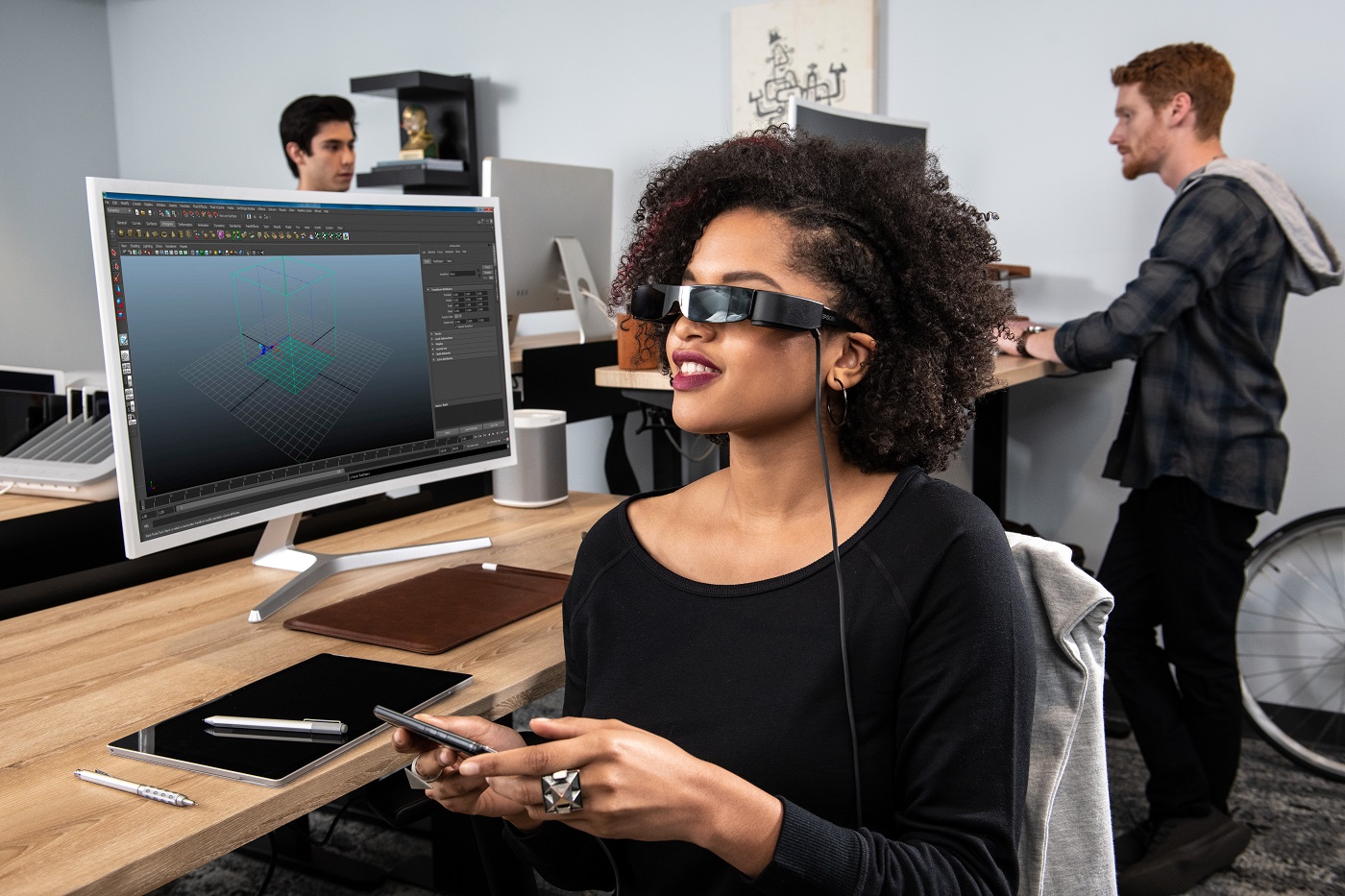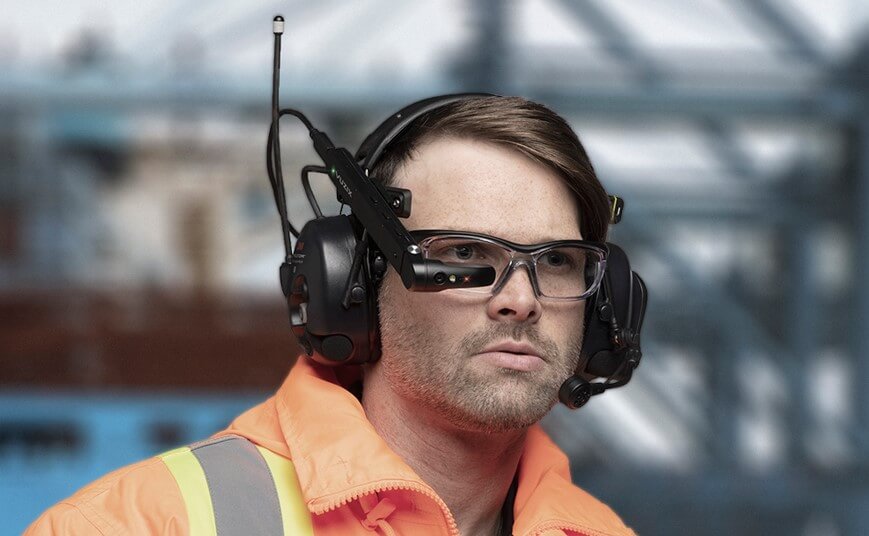2019 was a big year for XR headsets, applications, and technology. Here, we’ll be taking a look at the AR and MR headsets and glasses that caught our attention in 2019 and that we’ll be keeping an eye on going into 2020.
If VR is more your speed, don’t worry, we have a separate article covering VR headsets.
MR Headsets
Mixed reality involves a blend of virtual images and the user’s actual surroundings. That’s true of augmented reality as well but MR tends to be more finely integrated with the environment.
Because MR is more complex than AR, it requires a lot of computing power. As a result, it has the same wireless and tethered categories that we see with VR. It’s also the smallest and most expensive category of XR headset.
Wireless
These MR headsets work via bluetooth or wifi connections to an off-board computer. Wireless connections mean that you aren’t tethered to a device but that you need to be in an area with a good connection to run some applications.
HoloLens 2
Microsoft’s HoloLens 2 is one of the most advanced MR headsets on the market. Designed specifically for industry, the HoloLens 2 is priced beyond causal devices at $3,500. While there’s an affordable leasing option, Microsoft prioritizes working with companies and serious developers.

One of the big claims to game behind the HoloLens 2 is the design. Microsoft set machine learning to design the MR headset to be as usable as possible despite the fact that it works entirely using gesture controls. It also has access to Microsoft’s cloud computing platform.
Cloud computing lets the device run – and share – advanced applications from an onboard processor. However, sensitive information can be kept onboard for security reasons.
For more information on the HoloLens and how it compares to the next XR headset on our list, check out our older post here.
Tethered
Tethered MR headsets require a hardware connection to a computer. Wires might hold you back in some instances. However, they make for a faster, more reliable, more secure connection.
Magic Leap 1
The only real competition for the Microsoft’s HoloLens is the Magic Leap 1. More casual than the HoloLens, the Magic Leap 1 comes in almost $1,000 cheaper with packages starting at $2,300.
Despite the numeral, the Magic Leap 1 is the second generation of the MR headset – after the original Magic Leap One. With an upgraded NVIDIA processor, lighter weight, and longer battery life, the newer model is definitely a step up.

While the XR headset is tethered, it can be tethered to a “litepack” that fits in your pocket rather than a computer that sits on a desk.
Varjo XR-1
HoloLens being the only competition for Magic Leap doesn’t mean that they’re the only MR headsets out there. The XR-1 by Varjo is in a league of its own, coming in at a hefty $10,000.
With an 87-degree field of view, it has a wider field of view than any other XR headset. The same tech behind the VR-2 allows for photorealistic rendering of digital artefacts. It doesn’t only have some of the same hardware as the VR-2. It can actually switch between MR and VR, making it a true XR headset.

AR and MR Glasses
AR involves super-imposing digital artefacts over the actual landscape. As such, most AR experiences don’t require a dedicated headset. In fact, most of us still encounter most AR through mobile phones.
However, the potential for AR that didn’t require a mobile phone is huge. Information can always be before our eyes. Our hands can be kept free to work or play.
AR glasses have floated in and out of the market for a couple of years. However, with decreasing cost, increasing interest, and improving technology, a number of models have shown serious staying power in the last few years.
Some of the models discussed here are also meant for MR. However, MR smart glasses are smaller in size than the headsets discussed above. That makes them better for extended wear as well as wear away from the office. In most cases, it does also limit their computing power and controls.
Industry
Most producers of AR glasses make models specifically for industrial or personal use. Much of the difference is in the processing power and headset design.
Epson
Moverio by Epson isn’t just one model, it’s a whole line of products.

This article won’t take the time to look at them all. Each has a unique configuration of software and hardware including external tools and sensors for different jobs. Zone models are also designed to be fitted to the outside of hard hats. If you’re looking for AR glasses to revolutionize your worksite, it’s hard to do better than Epson.
The drawback? All models have a very limited field of view compared with other options.
Rokid
Rokid is preparing a model of smart glasses also intended for industry. They say that their platform uses AI for more immersive experiences but don’t expand on that process very much. Because the glasses aren’t tethered, they probably need to be cloud-based, similar to HoloLens.

Rokid glasses have a better field of view than other industry models and don’t have the obstruction that comes with our next entry. In fact, they look rather like large sunglasses.
Vuzix
The Vuzix M-Series doesn’t have the versatility of other smart glasses but what it does it does well. These headsets are essentially mounted cameras. Like Epson models, they can be fitted to a variety of different mounts to fit into any workplace.
As far as industrial smart glasses go, the M-Series has a great field of view but some of the attachments do get in the way of the real world.

If you’re a casual user interested in Vuzix, keep reading. They have a consumer model that we’ll get to in a bit.
Personal or Professional
Some glasses are intended for strictly professional or strictly personal use. However, this manufacturer walks the line.
ThirdEye Gen
The X2 by ThirdEye is marketed for “at home and in business.” The construction looks more like industry models, but that doesn’t mean that that’s how you need to use them.

Most of their platform is for healthcare, field service, and manufacturing. However, they do also support some games as well as some more general-purpose applications. The whole pre-order kit will only set you back $1,950, which is competitive given what you’re getting.
Personal
Smart glasses for personal use tend to have a more streamlined design. They’re also usually a bit less capable in terms of what they can do. Some even work by using a smartphone as the processor. While this isn’t true of all models, it should give you some idea of the computing power behind the following entries.
Norm
ARPost is always in a hurry to say good things about Norm. These smart glasses, which are scheduled to ship later this year, have a lot going on.

They can take video and photos. They can be controlled through touch, gesture, and voice, or through a companion mobile app. Despite working with mobile phones, there’s no wire. On top of all of that, they’re listed on Indiegogo for under $350. The only downside is that the 20-degree field of view is about half the industry standard.
Nreal
One of Norm’s main competitors is Nreal. At $500, Nreal is a bit more expensive but definitely still in the same market.

A controller and a tethered external computing pack make the Nreal a bit more bulky than Norm. However, it also gives them some extra functionality. Another big win for Nreal: you can order them with prescription lens inserts. It’ll cost you almost double but it’s still an advantage that a lot of competitors don’t offer.
Vuzix Blade
The Vuzix Blade is the consumer model by the company behind the M-Series discussed above. The Blade definitely has a more streamlined design. The clunky module that obstructs vision with the M-Series is also gone for the Blade.

Vuzix still makes photography and video the focus of the Blade. However, the Blade also works with social media applications, making it perfect for the bloggers and photographers out there building platforms. However, the Blade isn’t for just anyone with an Instagram as it will cost $800 to pick up a pair.
Takeaways
As XR technology grows, industrial and personal AR and MR headsets are only getting better.
In many cases, the line between professional and personal AR/MR headsets is blurring. That trend is one that we’ll definitely keep an eye on in 2020.




